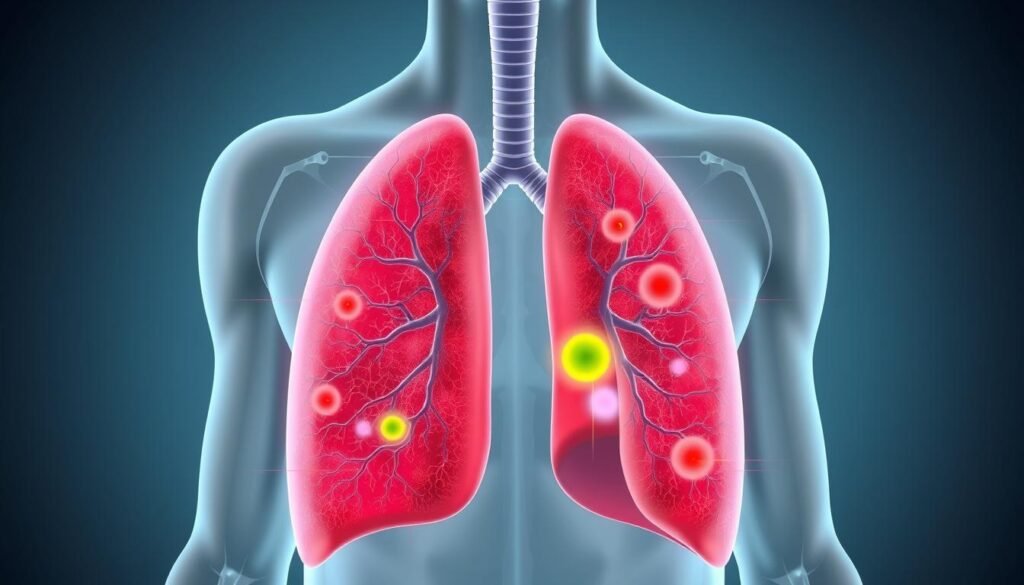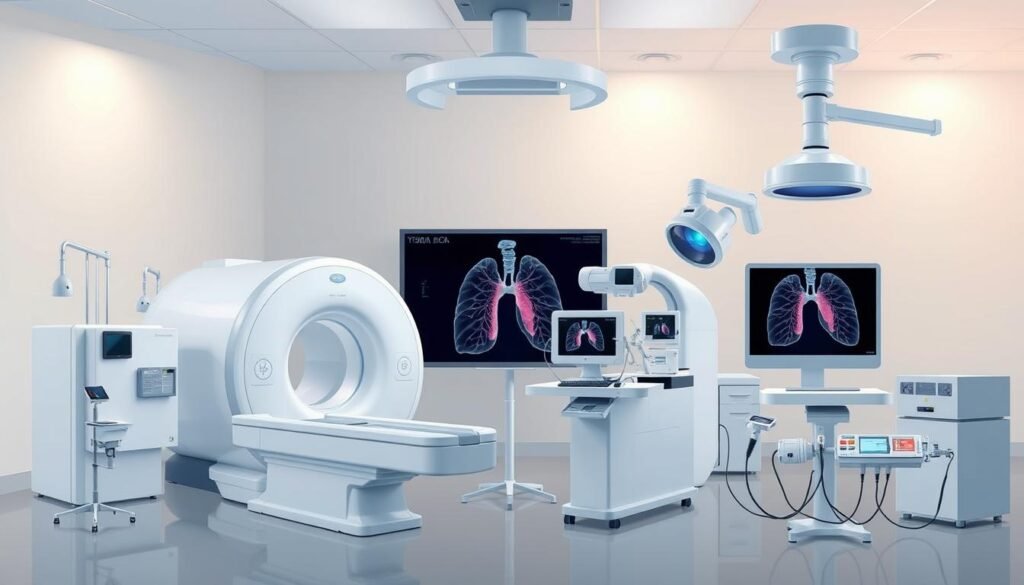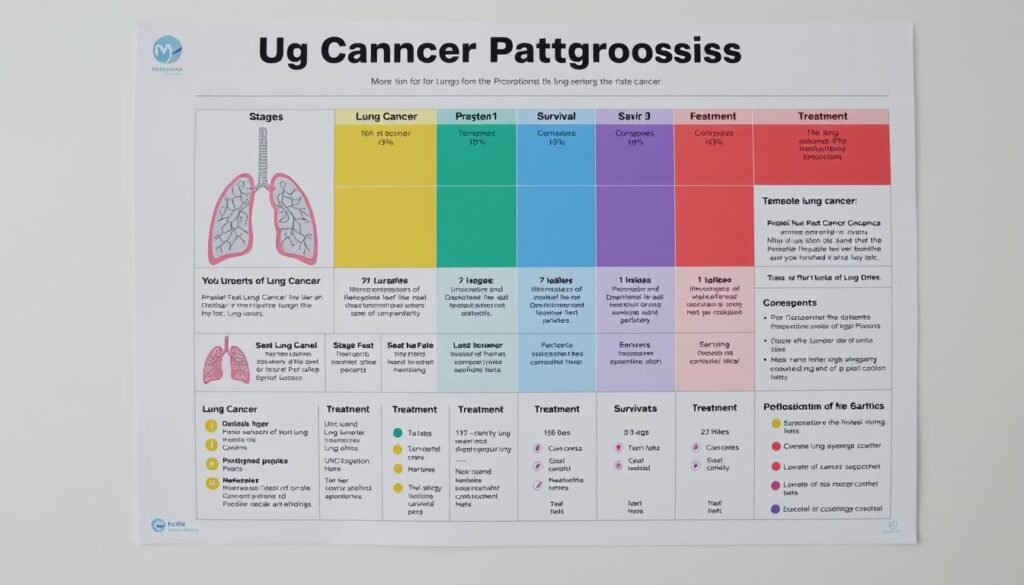Lung cancer is the top cause of cancer deaths in the US, with over 150,000 lives lost each year. Knowing how lung cancer is staged is key because it guides the treatment plan and results. The stage is determined by tumor size, location, if it’s in lymph nodes, or spread further. The TNM staging system helps doctors create personalized care for each patient.
We aim to explain why lung cancer staging is so important. We will cover the key steps and tests used to pinpoint the disease’s stage. You’ll learn the basics of the staging process and how it affects the outlook and treatment. This information is crucial for those facing lung cancer.
Key Takeaways
- Lung cancer can be categorized as Non-Small Cell Lung Cancer (NSCLC) or Small Cell Lung Cancer (SCLC).
- The TNM staging system is crucial for determining the appropriate treatment for lung cancer patients.
- Accurate staging improves the prognosis and helps tailor treatment plans to individual needs.
- Staging is influenced by factors like tumor size, location, lymph node involvement, and metastasis status.
- Understanding the stages of lung cancer can empower patients in their treatment journey.
Understanding Lung Cancer Staging
Lung cancer staging is key in understanding how serious the disease is. It uses the TNM system to rank the cancer. This system looks at tumor size, if it has reached lymph nodes, and if it has spread elsewhere. It gives a full view of how far the cancer has gone.
There are specific details for each stage of lung cancer. NSCLC stages range from I to IV. They can further break down into IIIA, IIIB, and IIIC, for example. A higher number means the tumor is larger and has spread more. SCLC, on the other hand, is labeled as “limited” or “extensive” based on its spread.
Doctors use imaging tests like CT and PET scans to stage lung cancer. These scans show which lymph nodes are affected. Even though these tests are not invasive, a biopsy might still be needed to confirm. Different biopsy methods are chosen based on where the tumor is.
It’s very important to get the lung cancer stage right. Many people find out they have SCLC when it’s already stages 3 or 4. NSCLC might be found earlier. Stage 1 lung cancer patients often have surgery that’s not very invasive. Later stages might need more intense treatments, like chemo, targeted therapy, or immunotherapy.
Grasping how lung cancer is staged is crucial for treatment. Doctors use this system to make the best plan for each patient. The goal is to improve how long patients live and how well treatments work.
Why Staging is Important
Knowing the exact stage of lung cancer is crucial for picking the right lung cancer treatment options. It lets healthcare workers see how far the cancer has spread. This way, they can make a plan that may increase the chances of beating the disease.
The lung cancer staging importance also sheds light on lung cancer prognosis. While it helps guess survival rates, it can’t tell how long each person will live. This is because everyone’s cancer is different.
Sticking to staging rules can be tough, though. In 2022, a survey found that many doctors didn’t know about key guidelines. Plus, almost all faced hurdles like patient worry about treatment delays and adding rules to their daily work.
New treatments and drugs from the FDA have made a big difference in fighting lung cancer. There are now surgeries that are easier on patients. These surgeries are less harsh and more accurate.
| Stage | Five-Year Survival Rate | Lung Cancer Treatment Options |
|---|---|---|
| Stage I Non-Small Cell Lung Cancer | 60% – 92% | Surgery, Stereotactic Body Radiotherapy, Molecular Testing |
| Stage II | Varies | Surgery, Chemotherapy, Radiation Therapy |
| Stage III | Varies | Chemotherapy, Radiation, Targeted Therapies |
| Stage IV | Lower Survival Rates | Targeted Therapies, Immunotherapy |
It’s important for both patients and doctors to understand how staging ties to treatment and outlook. Right staging is key for choosing treatments, which helps patients live longer and better.
Overview of the Staging Process for Lung Cancer
The journey of lung cancer staging starts when someone is diagnosed. It leads to important tests. At first, there’s clinical staging. Doctors use tests like CT scans and MRIs to see the tumor’s size and where it is. These tests help understand how far the cancer has spread.
Next, if surgery happens, comes a closer look at the tumor. This is called pathological or surgical staging. During surgery, doctors take a closer look at the cancer cells. This stage gives a clearer picture of the cancer’s spread. It might show new info compared to the earlier clinical stage.
Understanding the stages of lung cancer is key for doctors to plan the right treatment. Early and precise staging is very important. It affects how well someone might recover. It helps start treatments at the right time, making every step very important.
Key Factors in Lung Cancer Staging
Staging lung cancer looks at key factors. These factors are crucial for mapping out the disease’s progression. They help decide the best treatment and predict the outcomes. Important aspects include the size and place of the tumor, if cancer has reached the lymph nodes, and if it has spread further.
Tumor Size and Location
The tumor size in lung cancer greatly affects how the disease is staged. Usually, smaller tumors mean the lung cancer is in its early stages. This often leads to better chances of recovery. Where the tumor is located is just as important. Tumors in the center of the lungs might need different surgery types than those on the edges. Knowing these details allows doctors to create treatment plans that fit each patient.
Lymph Node Involvement
Lymph node involvement in lung cancer tells if the cancer has reached the lymph nodes near the lungs. If the cancer has spread to these nodes, it indicates a more serious stage. This information decides what type of treatment is needed. Finding out the lymph node status through scans or tissue samples helps doctors choose the right treatment method.
Metastasis Status
Finding out if metastasis in lung cancer has happened is key for staging the disease accurately. Metastasis means the cancer has moved to distant body parts. This situation greatly affects a patient’s outlook and the choice of treatment. Through regular checks and detailed exams, it’s possible to see if cancer has spread. This information lets oncologists pick suitable treatments like chemotherapy or targeted therapy.
| Factor | Details |
|---|---|
| Tumor Size | Smaller sizes often correlate with early stages and better treatment outcomes. |
| Location | Central tumors may require different surgical approaches compared to peripheral ones. |
| Lymph Node Status | Spread to lymph nodes indicates a more advanced stage. |
| Metastasis | Distant spread can lead to complex treatment decisions and lower prognosis. |
Lung Cancer Staging System
The lung cancer staging system is key for diagnosing and treating this illness. It uses the TNM classification. This looks at tumor size and location (T), if lymph nodes are affected (N), and if there’s metastasis (M).
Lung cancer can spread to the liver, bones, brain, kidneys, and adrenal glands. The staging goes from 0 to 4. It shows how big the tumor is and how far it has spread. For example, NSCLC might be stage IIIA, IIIB, or IIIC. This depends on the tumor size and if lymph nodes are involved.
SCLC is grouped into limited or extensive stage. Limited means the cancer is only on one side of the chest. Extensive stage means it has spread further. This classification helps doctors decide on treatments like surgery, chemotherapy, or radiation.
| Staging Classification | Description |
|---|---|
| Stage 0 | Occult stage, no evidence of tumor spread. |
| Stage I | Localized lung cancer, small in size, no lymph node involvement. |
| Stage II | Involvement of nearby lymph nodes. |
| Stage III | More extensive lymph node involvement; possibly unresectable. |
| Stage IV | Advanced cancer with distant spread to organs. |
The staging system for lung cancer is crucial for prognosis and treatment plans. Accurate staging is critical. It affects survival rates and the success of treatment, emphasizing its importance in managing lung cancer.
Staging of Non-Small Cell Lung Cancer
Knowing how non-small cell lung cancer stages work helps doctors plan the best treatment. Lung cancer stages range from I to IV. Stage I means the cancer is only in the lungs. Stage IV means it has spread far away. Each stage is determined by tumor size and if it has reached lymph nodes. These factors are key in deciding on treatment.
Imaging tests are crucial for understanding NSCLC well. Doctors use thoracic computed tomography (CT) scans to see if the tumor has spread locally. This is known as the T stage. To check for cancer in nearby regions (N stage) or far away (M stage), doctors use whole-body scans. Using both CT and PET scans together gives a clearer picture of the cancer’s spread.
The American Joint Committee on Cancer (AJCC) and the International Union Against Cancer (UICC) say NSCLC staging depends on the TNM system. This system explains lung cancer stages. For instance, T1 means the tumor is 3 cm or smaller. T4 means cancer has spread to nearby areas. T4 diagnoses are complex because of this spread.

Pathological confirmation of cancer spread is a must before ruling out treatment that could cure. When cancer reaches the T4 stage, deciding on treatment gets harder because the cancer may have spread to the middle chest area. Doctors may use mediastinoscopy or transesophageal echocardiography (TEE) to get a better look.
NSCLC stages greatly affect treatment choices and chances of getting better. Stage 3 cancer, for example, is divided into 3A, 3B, and 3C. Each one has different criteria for how far the tumor and lymph nodes have spread. Carefully examining these criteria helps decide on surgery and other treatments that might improve health.
Staging of Small Cell Lung Cancer
Small cell lung cancer (SCLC) is split into two main stages: limited and extensive. These stages are key as they guide treatment choices and outlooks for the patient. Knowing the stage of SCLC helps pick the right treatment and foresee patient results.
Limited Stage Definition
Limited stage shows cancer is in one lung and maybe close lymph nodes. About 1 in 3 people found with SCLC have it at this early stage. Those with limited stage can get strong treatments. This often means using both chemo and radiation with the goal of beating the cancer.
Extensive Stage Definition
Extensive stage means cancer has spread past the original lung. It may reach other lymph nodes or distant body parts. Roughly 2 in 3 SCLC patients are found at this advanced stage. Their treatment usually combines chemo and immunotherapy. This helps control the wide-reaching cancer.
Staging Tests Used in Lung Cancer
Knowing the stage of lung cancer is key to picking the right treatment. Special lung cancer staging tests give doctors important details about the disease’s spread. These tests, like scans and tissue samples, show the tumor and tell more about it.
Imaging Tests
Imaging tests for lung cancer are very important. They help find and measure tumors. They also check for spread to other places. The main types are:
- Chest X-rays
- CT Scans
- PET Scans
- Bone Scans
These methods let doctors see how cancer has moved in the body. PET and CT scans together can show if cancer has reached nearby or far parts.
Biopsies and Pathological Staging
Biopsies are key in finding out the lung cancer stage. Pathological staging in lung cancer uses tissue samples from different techniques:
- Needle biopsies (fine needle aspiration and core needle)
- Brochoscopy
- Thoracentesis for fluid analysis
- Mediastinoscopy and thoracoscopy for direct examination and sampling
These methods tell doctors about the cancer’s cells and how it might react to treatments. Even if first tests don’t find cancer, more tests could be needed. This ensures the diagnosis and stage are right. This leads to better treatment choices. For more about staging, visit this link.

How the TNM Staging System Works
The TNM system categorizes lung cancer into stages. It was created by Dr. Pierre Denoix and has changed a lot over time. There are three key parts: the tumor (T), lymph node (N), and metastasis (M). Each part gets a score that shows how far the cancer has spread.
The ‘T’ score talks about the tumor’s size. It goes from T0 to T4, with higher numbers meaning the tumor is bigger. The ‘N’ score tells us how many lymph nodes have cancer, from N0 to N3. More affected lymph nodes mean a higher ‘N’ score. The ‘M’ score checks if the cancer has spread to other parts with M0 meaning no spread, and M1 meaning it has.
This method lets doctors understand lung cancer’s progression better. It is very important for planning treatment and figuring out the outlook for a patient. Lung cancer is put into five stages, from Stage 0 to Stage IV. Each stage shows how serious the tumor is and helps predict patient outcomes.
Staging is key for both main kinds of lung cancer, NSCLC and SCLC. Most lung cancers are NSCLC, taking up 80%-85% of cases. It uses the TNM stages from 0 to IV. SCLC uses limited and extensive stages, adding more detail to the diagnosis and treatment plans.
For more on how the TNM system has changed lung cancer treatment, read this detailed review. It talks about the system’s changes and how they help doctors make decisions.
| Component | Classification | Detail |
|---|---|---|
| T (Tumor) | T0 – T4 | Size and extent of the main tumor |
| N (Nodes) | N0 – N3 | Number of nearby lymph nodes with cancer |
| M (Metastasis) | M0 / M1 | Presence or absence of spread to distant sites |
Understanding Prognosis in Lung Cancer Staging
Understanding lung cancer’s prognosis is key when figuring out its impact on life. The stage of lung cancer is very important in understanding what to expect. Early stages usually mean a better shot at lung cancer survival rates, while later stages can be more serious.
For non-small cell lung cancer (NSCLC), different stages show big differences in survival. About 65% of people with localized NSCLC might live five more years. But, this number drops to just 9% for those with cancer that has spread to distant parts. This highlights why catching the disease early is crucial.
The survival rates change if cancer has spread to nearby regions or further. With regional lung cancer, the five-year survival is about 37%. But if it’s distant, survival drops to 8%. These numbers show the importance of stopping cancer’s progress.
Other factors also affect the prognosis. This includes the patient’s overall health, weight loss, and gender. Generally, women have slightly better outcomes than men. Genetics and individual health play roles in how one responds to treatment, affecting the lung cancer prognosis.
The table below shows five-year survival rates for different stages of lung cancer:
| Type of Lung Cancer | Localized Stage | Regional Stage | Distant Stage | All Stages Combined |
|---|---|---|---|---|
| NSCLC | 65% | 37% | 9% | 28% |
| SCLC | 30% | 18% | 3% | 7% |

These numbers help us grasp how lung cancer’s stage deeply influences outcomes. They underline the need for quick medical check-ups and action to boost chances of surviving.
Adjustments to Staging After Treatment
Dealing with post-treatment lung cancer requires a close look at lung cancer restaging. This step checks how the cancer has responded to treatment and if it has come back. It helps decide the next steps in care. Teams often redo tests to get a full picture of the cancer’s change after initial treatment.
Staging is split into clinical and pathological types. Clinical staging is done before treatment. It uses exams, imaging tests, endoscopies, and biopsies. Pathological staging happens after surgery. It combines earlier test results with surgery findings.
The TNM system is key for adjusting lung cancer staging. It looks at the tumor size (T), lymph node spread (N), and if cancer has spread to other parts (M). Terms like TX, Tis, N0, and M1 show how the cancer stage has shifted.
Restaging is vital when cancer returns or grows. It shapes the plan for treating the cancer. Right staging adjustments lead to better management. They also help forecast the recovery chances for patients.
Conclusion
Lung cancer staging is crucial for patients and healthcare workers. It helps assess how far cancer has progressed. This knowledge guides the treatment plan and choices for care.
Non-small cell lung cancer (NSCLC) makes up most cases, around 80-90%. Knowing the correct stage is key. It affects how well treatments work and what results can be expected.
The stage of lung cancer is closely tied to how a patient might do. For example, bigger tumors often mean a worse chance of getting better. This insight comes from a big study of over 77,000 patients from around the world. It helps doctors come up with the best plan for each person, based on their specific situation and cancer stage.
Understanding lung cancer staging helps make better treatment decisions. Finding the disease early can greatly increase the chance of surviving. That’s why it’s important to quickly spot signs of lung cancer.